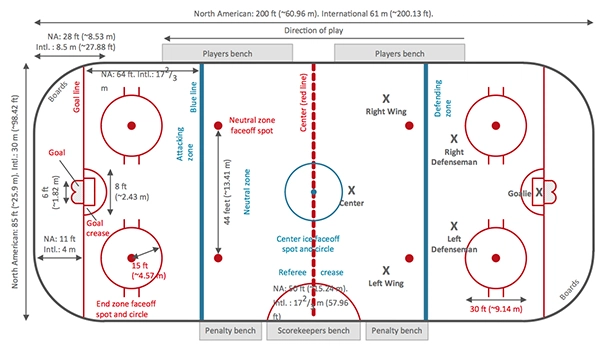Did you know? The first recorded public indoor ice hockey game took place in Montreal’s Victoria Skating Rink in 1875 between two teams of McGill University students. (Wikipedia)
From that moment, ice hockey became one of the most prominent sports across the globe.
It has vast popularity and is also one of the most anticipated games in the Olympics.
Due to its immense fan following, many people think about how big is a hockey rink where players face off with each other. And did the size vary according to the stage or level of the matches?
So, this blog post aims to provide complete information about this segment and detailed insights about the rink demographic.
Let’s begin!
Key Measurements in Ice Hockey
Length and Width:
The rink’s dimensions are one of the most defining aspects of hockey, shaping both strategy and player movement.
The International Ice Hockey Federation (IIHF) uses a larger surface, usually 200 feet by 100 feet (30.48 meters), while the NHL uses a regular rink that is 200 feet long and 85 feet (about 26 meters) wide.The game’s dynamics are significantly changed by this 15-foot width disparity. A narrower NHL rink creates a faster, more physical style of play, with less open ice and more frequent body contact. Players must make quicker decisions, as they have less space to operate, leading to a high-tempo, north-south style of hockey with more emphasis on dump-and-chase tactics.
In contrast, the wider IIHF rink allows for a more expansive, east-west game emphasizing skill, puck movement, and perimeter play.
Offensive strategies that rely on tight checking and rapid zone transitions in the NHL often need to be adapted for international ice, where defenders have more room to recover. Offensive players can utilize additional space to create scoring opportunities.
For teams transitioning between the two formats, adaptability is key. Players accustomed to the NHL’s confined playing area must adjust their positioning and timing to avoid overcommitting in the larger international setting.
To make sure that strategies created for a small rink do not expose their team when playing on a larger ice surface, coaches must also improve their systems.
Goal Line to End Boards:
One of the lesser-discussed but crucial rink dimensions is the distance between the goal line and the end boards. In the NHL, this space is approximately 11 feet, whereas in international play, it can range from 13 to 15 feet.
This seemingly minor variation has profound implications for goaltenders, defensive strategies, and offensive play execution. Goalies can challenge plays more aggressively in the NHL due to the shorter space behind the net.
They can use their stick and body positioning to stop wraparound attempts or fast passes to the slot. Closer end walls allow defenders to pin opponents more successfully against the boards without creating too much space behind them, which results in tighter clashes in the corners.
Additionally, as defenders swiftly close gaps in the little area available, offensive players must make snap decisions.
The extra room behind the net on international ice allows for a more patient, methodical approach. Playmakers have additional space to operate, potentially setting up high-percentage scoring opportunities with precise passes.
The increased distance also discourages overly aggressive goaltending, as net minders must remain more conservative in their positioning to account for wider passing lanes and longer wraparound attempts.
This difference demands defensive adjustments, emphasizing protecting passing lanes rather than solely pressuring puck carriers.
Corner Radius:
Although it may not seem like much, the rink’s corner curvature has a big impact on gameplay, especially during puck retrievals and skirmishes along the boards.
The NHL generally features a tighter, more pronounced corner radius, whereas international rinks tend to have a broader, more gradual curve.
In the NHL, sharper corners compress play in the defensive zone, making it easier for defenders to trap opposing players and force turnovers.
Because pucks ricochet off the boards more sharply and enable rapid passes or bank plays to open teammates, the sharper angle also quickens the play.
Agile players who excel in tight spaces—such as shifty forwards or quick-reacting defensemen—thrive in this environment, as their ability to pivot and change direction rapidly gives them an advantage in puck battles.
In contrast, a larger corner radius on international ice smoothes out puck movement, lowering the frequency of surprising bounces and making the game slightly less frantic.
This allows for longer, sweeping passes and more controlled zone exits, which benefits teams who prioritize possession and planned play.
However, it also makes it harder for defenders to trap opponents in tight spaces, leading to more prolonged offensive zone time for teams with intense cycle games.
Ultimately, these variations in rink dimensions—length and width, goal line spacing, and corner curvature—highlight the importance of adaptability in hockey.
Players and coaches who understand and adjust their strategies accordingly can maximize their effectiveness, whether competing in the NHL or on the international stage.
Interesting Facts
Amateur ice hockey leagues began in the 1880s, and professional ice hockey originated around 1900.
(source)
Why Rink Size Matters in the Game
The implications of rink size are substantial, permeating elements ranging from player fitness to team tactics. Larger rink sizes usually result in variations in energy costs since players must occupy and patrol more ice. This affects their physical conditioning as well as the game’s general speed.
- Effect on Player Conditioning: Hockey demands exceptional endurance and discipline, and the rink size often prescribes the type of conditioning players need.
Skaters must exhibit remarkable stamina and nimbleness in sprawling international rinks to cover the ice efficiently.
Tailored training regimens designed for distinct rink sizes can have a substantial impact on a team’s performance, giving them an advantage while adapting to different play situations.
- Impact on Game Strategy: Hockey game strategies hinge on understanding every inch of the rink.
On small NHL rinks, the game is defined by swift transitions and tighter defenses, forcing a quick-thinking playstyle.
Conversely, larger international playing surfaces encourage more expansive play, with long passes and strategic player spacing emerging.

Intriguing Insights
This infographic here describes the complete structure and precise dimensions of an ice hockey rink
Real-World Examples
International tournaments spotlight the challenges and adaptations required due to various rink sizes. For instance, even experienced NHL players may require some time to adjust to the larger ice surfaces used in Olympic competitions.
This scenario offers a unique glimpse into the strategic recalibrations teams typically employ, where every extra foot of ice can transform a single tactic from successful to obsolete.
The Evolution of Rink Sizes in Ice Hockey
Ice hockey has witnessed an evolution in rink dimensions rooted in a complex interaction of tradition, the physicality of players, and technological advancements in rink construction. Historical differences in dimensions were controlled by social standards and the amount of available space.
Modern rinks have been greatly influenced by advancements in rink engineering, like ice-making technologies and materials used in boards and dasher systems, as examined at sites like ScienceDirect.
These advancements have standardized dimensions and influenced gameplay by enhancing ice quality and player safety. Today, standards set by leagues like the NHL and IIHF aim to balance players’ safety with competitive integrity, reflecting the sport’s growth and its intersection with modern professional standards.
Resources for Further Information
This text examines the complex nature of rink design to comprehensively explore how rink size affects various aspects of ice hockey. Important information about the regulations and guidelines controlling international rinks and game norms may be found in the IIHF’s extensive reference.




